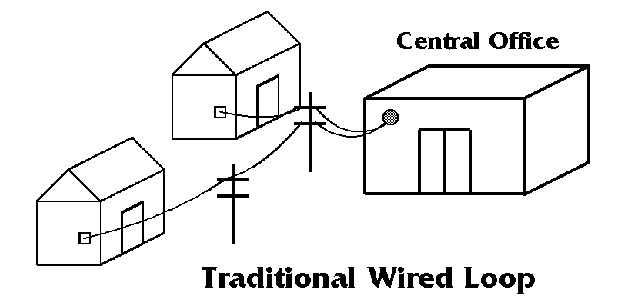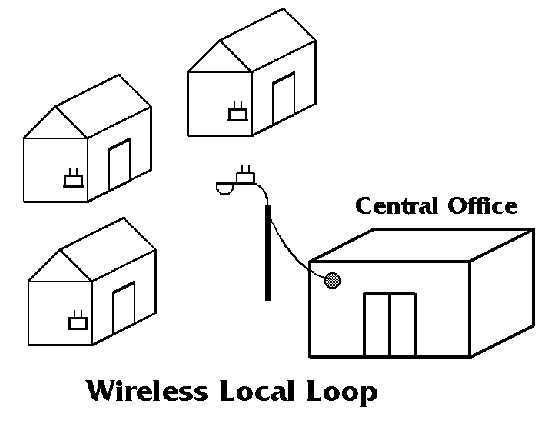| This article first appeared in the May 1997 issue of Monitoring Times. |
Local Service Scramble
It is often said that history repeats itself. In 1903 more than half of all cities and towns in the United States were served by at least two telephone companies, each offering local service. Now, due to the Telecommunications Act of 1996, competition in the local telephone service market will no longer be a thing of the past. The difference this time will be that much of the service will probably be wireless.
RURAL RADIOTELEPHONE SERVICE
In some extremely remote rural areas home telephone service is already wireless, and has been for more than a quarter of century. Where it is not economically feasible for the local telephone company to run wire for basic service they have often chosen to operate what the FCC calls Rural Radiotelephone Service. Customers use paired channels in the 150 MHz and 450 MHz bands with equipment and quality almost identical to the pre-cellular mobile telephone service. In fact the VHF and UHF allocations continue to be shared between rural radiotelephone service and one-way or two-way public land mobile service (the old Improved Mobile Telephone Service). These analog channels provide a full-duplex (both parties can speak and hear at the same time) radio link for remote households to reach the public switched telephone network (PSTN). The channels are often shared by several customers, so that just as with a party line callers have to wait until others are finished before placing a call. When a channel is available the sound quality may be poor, making conversations and modem calls difficult.
Transmitter Center Frequency
VHF Channel Pairs
| Base | Mobile |
| 152.03 | 158.49 |
| 152.06 | 158.52 |
| 152.09 | 158.55 |
| 152.12 | 158.58 |
| 152.15 | 158.61 |
| 152.18 | 158.64 |
| 152.21 | 158.67 |
| 152.51 | 158.77 |
| 152.54 | 158.80 |
| 152.57 | 158.83 |
| 152.60 | 158.86 |
| 152.63 | 158.89 |
| 152.66 | 158.92 |
| 152.69 | 158.95 |
| 152.72 | 158.98 |
| 152.75 | 158.01 |
| 152.78 | 158.04 |
| 152.81 | 158.07 |
UHF Channel Pairs
| Base | Mobile |
| 454.025 | 459.025 |
| 454.050 | 459.050 |
| 454.075 | 459.075 |
| 454.100 | 459.100 |
| 454.125 | 459.125 |
| 454.150 | 459.150 |
| 454.175 | 459.175 |
| 454.200 | 459.200 |
| 454.225 | 459.225 |
| 454.250 | 459.250 |
| 454.275 | 459.275 |
| 454.300 | 459.300 |
| 454.325 | 459.325 |
| 454.350 | 459.350 |
| 454.375 | 459.375 |
| 454.400 | 459.400 |
| 454.425 | 459.425 |
| 454.450 | 459.450 |
| 454.475 | 459.475 |
| 454.500 | 459.500 |
| 454.525 | 459.525 |
| 454.550 | 459.550 |
| 454.575 | 459.575 |
| 454.600 | 459.600 |
| 454.625 | 459.625 |
| 454.650 | 459.650 |
As with most technologies, cost is the driving factor. The average cost for rural telephone service exceeds $3000 per household while the total cost for a urban or suburban wired local loop averages between $1200 and $1800. In order to see what comprises these figures, let's take a look at what makes up a local loop.
SOME JARGON
In a traditional wired environment, the pair of wires connecting your telephones to the outside world is called a local loop. All the wires inside your house are termed "premise wiring" and connect to the "drop wire" (named from the image of dropping the wires from the telephone pole into your house) at a Network Interface Point (NIP), also known as the "demarc" or demarcation point. This point separates your responsibility from the phone companyís - everything from the NIP to inside your house (the premise wiring) is your problem, and everything from the NIP outside your house is their problem. A number of drop wires from your neighborhood all run to a junction box or wiring block and are combined into a distribution cable. Several distribution cables join up to form a feeder cable, which may have more than 2500 drop wires in it. This huge bundle of wires runs into your local central office, which provides your telephone service. Inside the central office, of which there are about 20,000 in the United States, is a device called a switch that directs incoming and outgoing calls to the proper place. Central offices connect to each other over interoffice trunks, which can take the form of wires, microwave links, and more commonly now fiber optic links.

Telephone companies that serve urban and suburban areas average over 300 subscribers per square mile where rural telephone companies average less than five subscribers per square mile. The typical cost for the switch and associated equipment is between $100 and $200 per customer, whether urban or rural. Maintenance, planning, and other network costs can add another hundred or two (or more) to that number. A copper telephone line in an urban or suburban area will cost the telephone company somewhere between $500 and $1000, depending on how densely the population is situated. In rural areas this is much higher, since distances are greater and the high labor and material costs are spread across a much smaller number of users. In the interest of providing telephone service to everyone (often referred to as "universal service") the government provides subsidies to rural telephone companies to keep the rates they charge their customers affordable. The bottom line here is that unless suppliers can provide local loop service for less than $1200 to $1800 per user there will be little interest from the telephone industry. Before 1996 there was another reason for little interest in domestic wireless loop technology -- regulatory history.
SOME BACKGROUND
The Modified Final Judgment (MFJ) that broke up the monolithic Bell System in 1984 created rules that have just recently changed under the Telecommunications Act. The MFJ split the nation into more than 160 local access and transport areas (LATAs) and allocated the former Bell System local telephone service to seven new Regional Bell Holding Companies (RBOCs). These holding companies were built up out of smaller organizations called Bell Operating Companies, who actually provided local telephone service. In exchange for the grant of local monopoly power the RBOCs were prohibited from providing long distance service (among a lot of other things). Local dialtone service and connections between two points entirely within a single LATA was provided by a single Local Exchange Carrier (LEC), who between the RBOCs and more than 1300 independent telephone companies still provide more than 95% of the nationís local phone service. However, under the MFJ, almost all service between two points that were not within the same LATA had to be provided by one of many Inter-Exchange Carriers (IXCs), or long distance companies, even if the two LATAs were both within the service area of the LEC. Long distance providers became fiercely competitive and drove prices down, but LECs remained the only source for local phone service.
What the Telecommunications Act did is open up the $100 billion local telephone service business to competition. Small companies and RBOCs from other areas are now allowed to compete with the incumbent LECs, who must share their networks with competitors, including everything from facilities to rights-of-way and telephone poles. LECs, in exchange, can now provide long distance service outside of their service area, and will be allowed to do so within their area after proving how well they've allowed access to competitors. It's not much of an exaggeration to say that everyone will be able to compete everywhere.
Wireless loop technology has been sold in developing countries for some time now, allowing the government (in most countries the telephone system is controlled by the government) to quickly provide phone service in selected areas without the expense and other difficulties that come with running wires to each customer. Motorola, Ericsson, and Hughes Network Systems, as well some smaller firms, all market fixed wireless loop products for use in undeveloped or remote areas. Most of them are basically repackaged radio equipment with a single analog telephone line interface operating over traditionally mobile frequencies.
WIRELESS LOOP REDUX
A recent announcement by AT&T Wireless Services and AT&T Laboratories takes local loop bypass to the next level. Field tests will begin in the Chicago area later this year of their fixed wireless loop technology operating at PCS frequencies. Customers will continue to use the same wired telephones and answering machines they use now, except that instead of copper wires running out to the street, each house or small business would have a pizza box-shaped transceiver connected at the NIP. Each of these transceivers would communicate with a neighborhood antenna mounted on a light pole or other structure. The antenna, which could serve upwards of 2000 homes, would be directly connected to AT&T digital switches, completely bypassing the underground or overhead wires that make up most existing telephone service.

This is more than just a replacement for standard analog telephone service. The transceivers will initially provide a 128 kilobits per second (kbps) digital connection, comparable to Integrated Services Digital Network (ISDN) services being offered by some LECs. Customers will have the flexibility to use that connection as they see fit on an on-demand basis. For instance, the customer could connect to the Internet using the full 128 kbps capacity, then downshift to 64 kbps in order to make a voice call, then resume web surfing at 128 kbps or terminate the data connection and set up a second voice call while the first one is still open. Computer connections will not be hampered by the current speed limitations of traditional modems since the data will be digital from end to end without ever being converted to analog. If 128 kbps isnít fast enough, AT&T promises that the transceivers will be software-upgradable (no hardware changes necessary) for even higher bandwidth. AT&T claims their internal cost will be less than $1200 per household, which puts them beneath the cost threshold discussed above.
For an additional $300, customers will be able to purchase a "personal basestation," which will allow them to use their digital cellular or PCS handset as a cordless phone while at home. Calls made using the personal base station will be charged at the lower wired telephone rates instead of the traditional per-minute air-time rates.
Will it come to your neighborhood? AT&T says it depends on the outcome of the Chicago trials, but theyíve spent a lot of money to put this kind of technology in the hands of consumers. Their transceivers have been designed operate in a 10 MHz block of broadband PCS spectrum, and in the recent FCC auctions AT&T won 21 licenses in the 30-MHz A and B blocks and 222 licenses in the 10-MHz D, E, and F blocks. This gives them access to 93% of the U.S. population, but with up to half a dozen wireless providers competing in large markets several wireless loop solutions may be available. Other companies, including Siemens Stromberg-Carlson, Lucent Technologies, and Motorola have expressed interest in manufacturing wireless local exchange equipment, so this may become a large market indeed.
If all this telephone jargon has you confused or you're looking for more information, check the PCS Front Line homepage at http://www.grove.net/~dan. Comments, criticisms, and questions are always welcome at dan@decode.com. Happy monitoring!